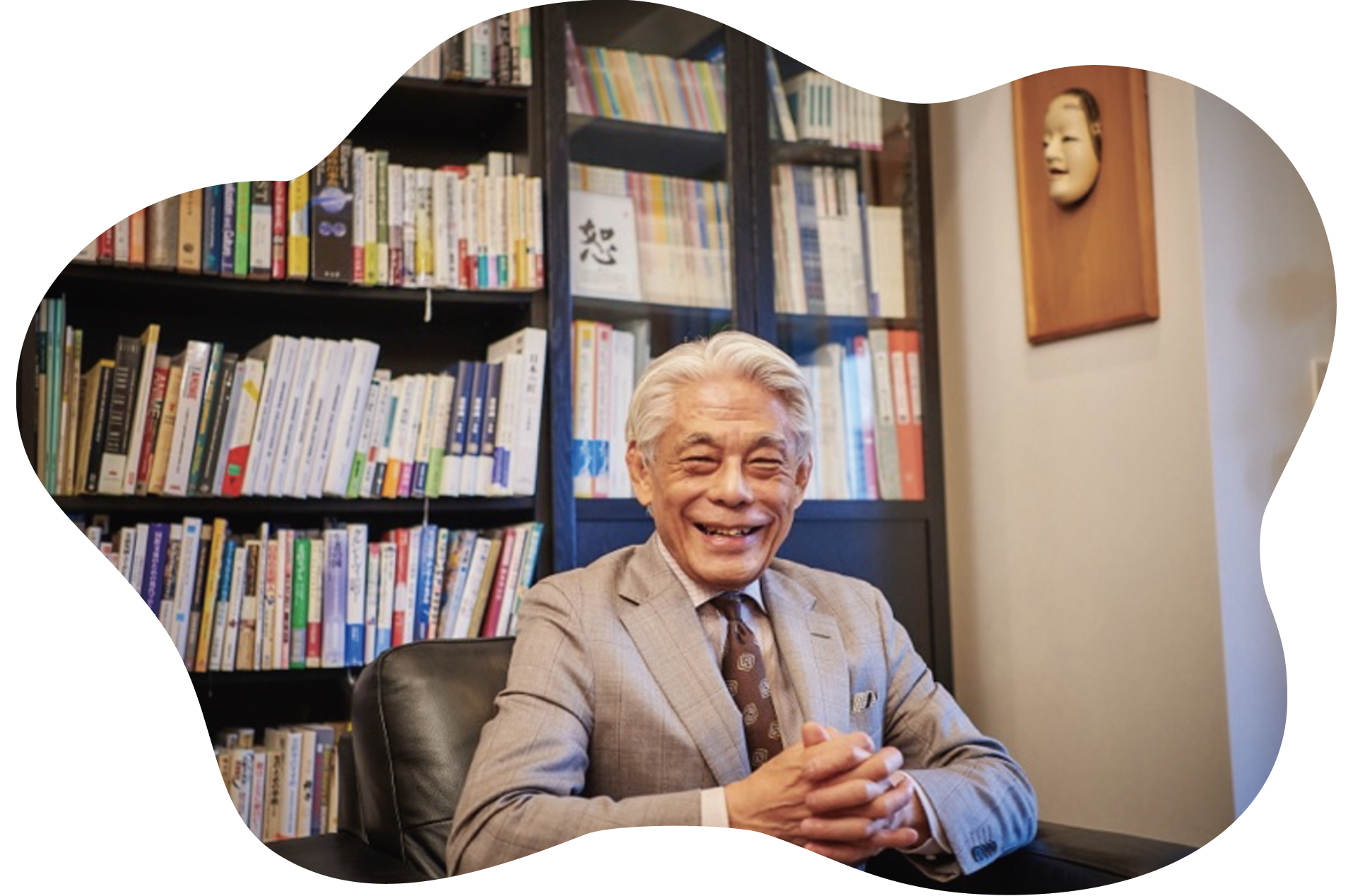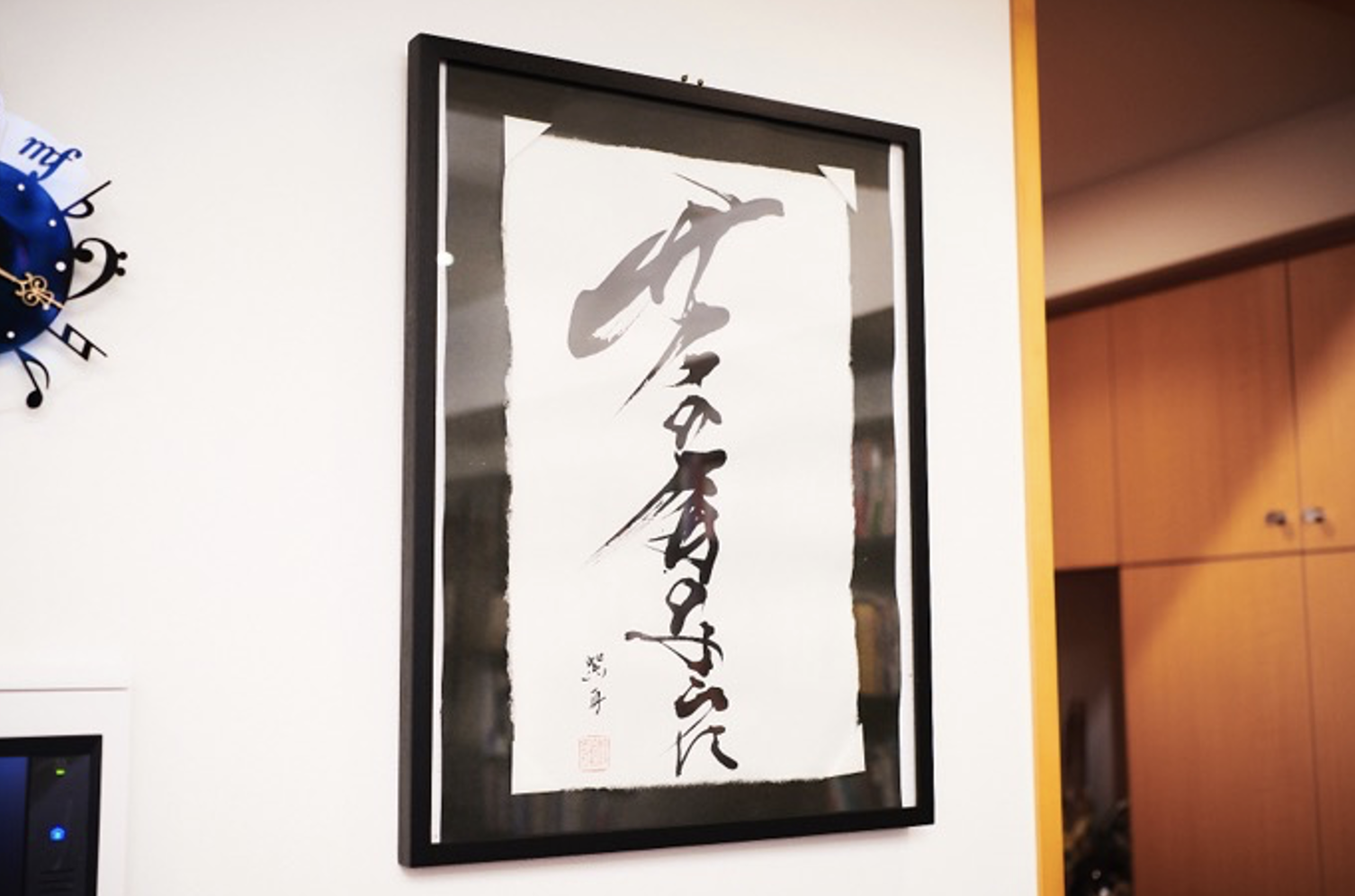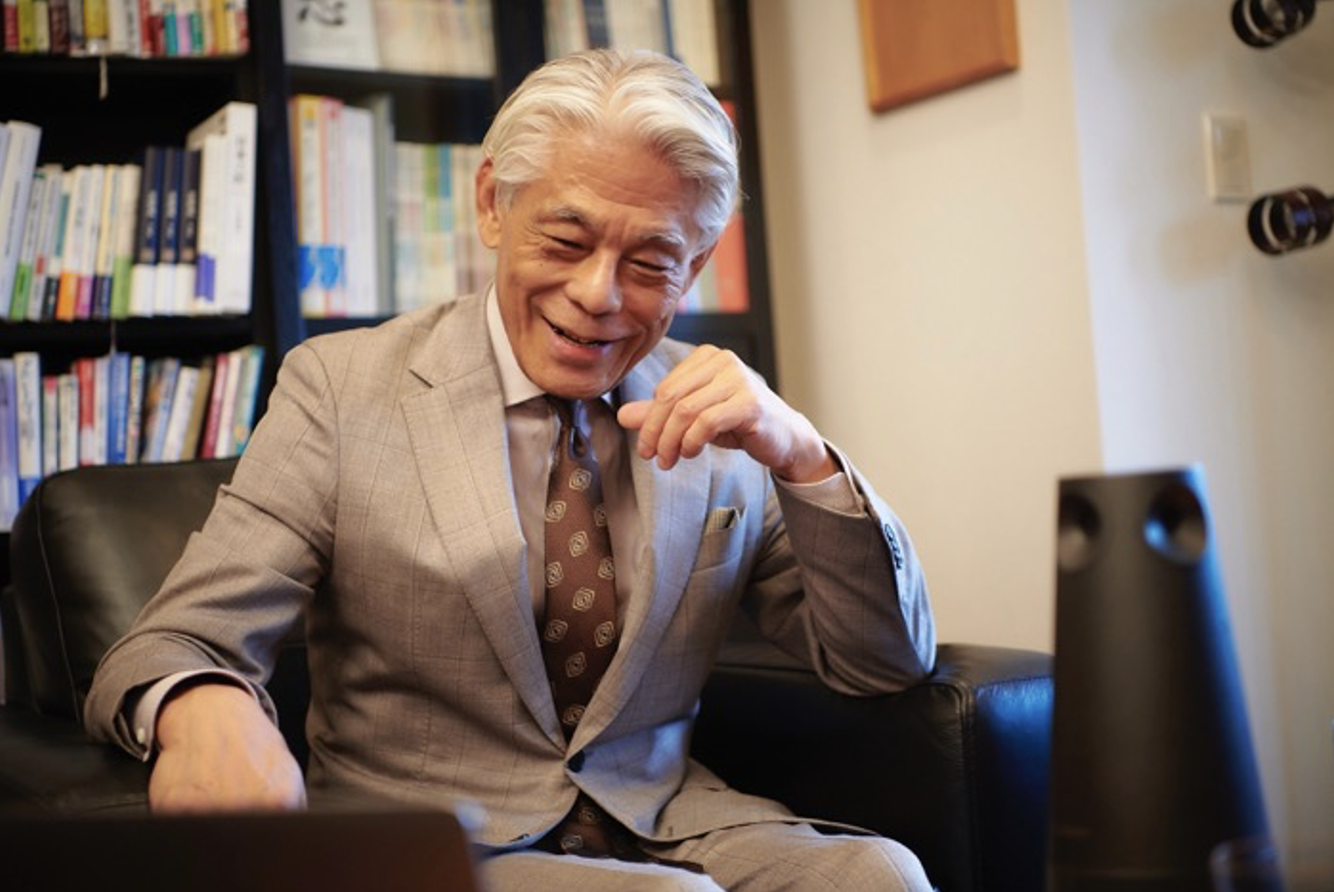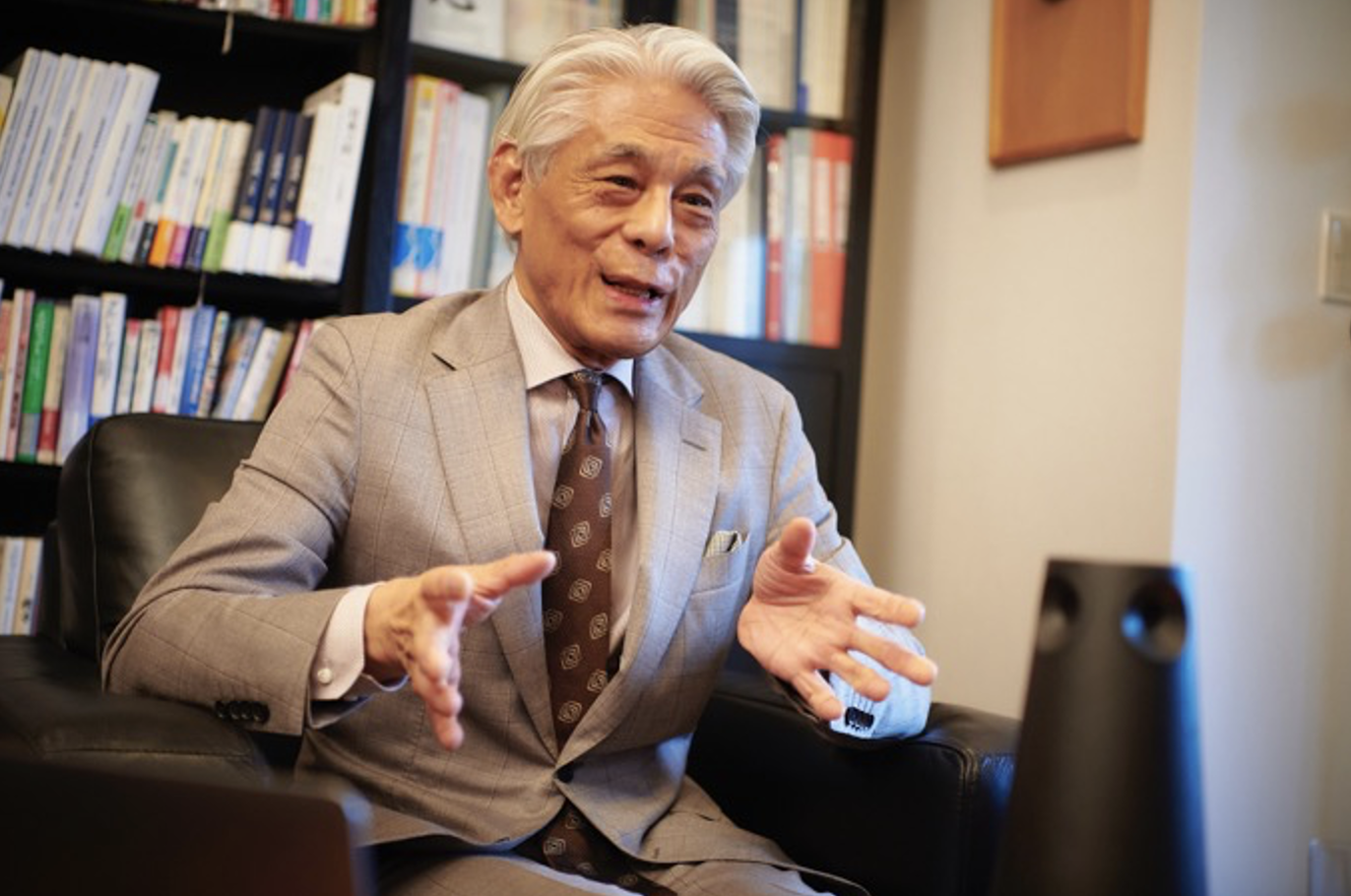

Photos by Tsunaki Kuwashima (KAIBUTSU)
ー
Today we are paying a visit to the Kondo Institute for Culture & Diplomacy, headed by Seiichi Kondo, a former Commissioner for Cultural Affairs who worked for many years for the Ministry of Foreign Affairs of Japan. The bookshelves lined with interesting books produce the calming atmosphere of a university professor’s research laboratory.
Oh, I see a book that seriously discusses the subject of Pokemon!



Dr. Kondo
To learn about people, I think it is best to try and approach them from various angles. The book genres are very diverse because we receive many free copies of books. I used to organize them into categories, but now they’re arranged quite randomly. Still, it’s interesting to note the connections between the books that are next to each other by chance, isn’t it?


ー
As well as books, this room is decorated with masks and handicrafts, paintings, calligraphy, and other works of art from around the world.
Dr. Kondo
This work is by the calligrapher Sisyu. The interesting thing about calligraphy is that artists inject their own thoughts and feelings on top of the inherent meaning of the characters. In addition to the elegance of characters written in ink, the blank spaces left over also have great meaning.
Sisyu once held an interesting exhibition that allowed viewers to experience the blank spaces. The calligraphy jumped off the paper. The characters appeared three-dimensional, like sculptures. And blank space seemed to envelop them, like air.


What reaction do you get when you try to explain this kind of thing to people overseas?



Dr. Kondo
Europe also has calligraphy and other kinds of art featuring beautifully written characters and text. They are also very interested in calligraphy, so they would say “wow” at seeing this. They would sincerely be amazed at the three-dimensionality of the characters. When I explain the importance of blank space, though, they don’t get the point right away in many cases. They view blank space as a waste; as the leftover space after the page is filled with expressive content.
In Japan, we value blank space, however. “Space” is also important in music. And the intervals of silence between the words we speak add different nuances. Communication that is almost invisible or inaudible is valued. I think the level of attention that Japanese artists give to such details is a characteristic of our culture.
Yes, blank space , silent pauses, and nothingness are important.



Dr. Kondo
That’s right. There is still something there, even if it happens to have no form or color. In English, empty space is seen as a void, as nothing, as “zero.” Whereas in Japanese culture, space is never considered “zero.” It has its own existence.
The president of Amano Enzyme told me that you have said that while scientific knowledge is useful for business and developing stuff, for important decisions about the future, like when we are at a crossroads in life, we should make use of cultural knowledge from the study of history and other liberal arts, which are quite different from science. This viewpoint really resonated with him.



ー
Let’s begin then by asking “What is culture?”
Dr. Kondo
In a sense, culture and enzymes area similar; they are invisible things. Consider, for example, the consistent culture that a local community or family has. It is something that connects people to each other through their mind and spirit. The mind itself is invisible. It is not in the heart, or the brain. No matter how much we break it down reductively, we cannot find its molecules or atoms. We can look for it in graves and memorial monuments, but there is no mind to be found, nor any life. We can’t predict the future, but so far at least, modern scientific methods have not been able to analyze the human mind.
In the attempt to describe this invisible mind, all kinds of artistic expressions have arisen. Whether a masterpiece made by a great artist or a teacup made by a hobbyist potter out of clay, behind all material creations there is a human mind.


Even the emotions of the mind, like excitement or nervousness, are invisible to others, aren’t they?



Dr. Kondo
Exactly! Human societies are essentially built on invisible things, like love, hate, sadness, and hope.
Think of the expression “to see.” It doesn’t just mean capturing physical information with the eyes. It also applies to situations that have nothing to do with the sense of sight, such as “seeing the strategy of a competitor” or “seeing the private feelings of a lover.”
In other words, it means “to guess” or “to imagine.” A kind of sixth sense.



Dr. Kondo
As well as sight, we also have hearing, smell, touch, and taste. We are equipped with organs that are receptive to each of the five senses, which we use to understand the world. But we can only perceive a tiny fraction of everything that exists in the world. Our eyes can only take in information from the visible light that reflects into them. Similarly, our ears cannot hear the full range of sounds.


Dr. Kondo
Thanks to scientific advances, we can now see things that are invisible to the naked eye using instruments such as microscopes. Information technology has allowed us to speak with people anywhere in the world. But all this power has its limits of course. We tend to think that the only real things in the world are those we can see and touch with our hands, but that is far from the truth.
As our scientific tools, like electron microscopes and space telescopes, get more advanced, we are rapidly learning more about things that we previously could not perceive.



Dr. Kondo
Science is amazing at enabling us to see and hear more and more things, but regardless of how many powerful instruments we develop, we will never ever be able to perceive the whole forest of life. Yet, many people still think that what we cannot see does not exist, an attitude that reflects a terrible human arrogance in my opinion.
If we fail to treat nature with humility, we will eventually commit grave mistakes. I fear that we are already doing so. It is vital to keep in mind that there are many wonderful things that we simply cannot see.
ー
In your books and lectures, you say that understanding the limitations of the five human senses and approaching nature with humility are characteristic aspects of Japanese culture.
Dr. Kondo
Westerners, especially those who take pride in the fact that modern rationalist civilization emerged in Europe, still view humans quite separately from the rest of nature. Descartes’ famous phrase “I think, therefore I am,” is said to have been a catalyst for this outlook. Under this worldview, humans have cut themselves off from their environment, seeing themselves as separate.
Human beings observe things outside of themselves, formulate hypotheses about them, conduct various experiments, and produce results to confirm the hypotheses. They then conclude that they objectively understand the thing. “Oh, nature works according to this law, or rule.” It is the sustained development of this process that has led us to the Western civilization of today, giving rise to molecular biology and space rockets.


Dr. Kondo
This Western way of thinking is dualistic, in the sense that it separates everything into “subject” and “object.” However, many things cannot be divided this way. If we are too accustomed to dualistic thinking, it is hard to know how to deal with the invisible things we have been talking about. This worldview is fundamentally different from the approach of Japanese culture, which views human beings not as separate from the natural environment, but rather as a part of it.
ー
How did this way of thinking originally take root in Japan?
Dr. Kondo
I think the climate and natural features of Japan were a significant influence. The Japanese archipelago has a relatively mild climate and four seasons, with flowers blooming in spring and delicious foods ripening in autumn. On the other hand, there are also massive earthquakes, volcanic eruptions, and typhoons at times. We have always lived at the mercy of nature, both suffering its devastation and enjoying its blessings.
Ultimately, we are part of nature. Even if we suffer a terrible hardship, we will later enjoy nature’s rewards. So, there is no sense in resisting. I suspect that this is how that comprehensive acceptance of nature that characterizes Japan evolved. In contrast, with its dualistic and divisive approach to nature, the West developed the power of science and technology, which has superficially overcome the limitations of nature. This is one of the reasons behind the differences in the two cultures I would say.


At a temple in Kyoto called Manshu-in, there is a “mound of microbes” to commemorate the souls of microorganism used to make sake, soy sauce, and miso. Researchers at Amano Enzyme have expressed their sympathy with the idea of building such a mound because in the course of their work, day after day, the lives of trillions of microorganisms are sacrificed.
However, when I take overseas visitors to see the “mound of microbes,” I note that most Westerners struggle to understand or appreciate the idea. On the other hand, Chinese and other Asians seem to have a similar understanding to Japanese people.



Dr. Kondo
The truth is that human beings are a part of nature and that we function in interconnection with our surrounding environment. We receive the source of our life force from nature, a process assisted by enzymes. And when our cells become old, they are removed from the body and put back into the cycle of nature. We now understand this process thanks to biology, but we were ignorant of it in the past.
Yet, in Japan, people seem to have always understood this concept, without the need for natural science processes of objective analysis and experimentation. Perhaps one reason that we have been able to sense so much is that we have lived in relative tranquility through transitions of nature without experiencing life or death struggles for survival as a people.


Dr. Kondo
The Western rationalist method, which gave birth to modern science, is very valuable in the sense that it leaves aside what cannot be seen with the eyes or conceived with the mind, focusing only on what can be reliably understood. Taking advantage of the laws of nature, it makes life more convenient and easier. However, if taken too far, it becomes destructive to nature. It tends toward the extreme view that nature is merely a source of materials and resources for humans.
Taking the view that human beings are a part of nature, Japanese culture has tended to try and preserve the natural order of things. I believe that if we can apply Western rationalist scientific methods over this kind of cultural foundation, we can develop a more well-balanced society.
In a very accessible way, Mr. Kondo explained the cultural differences between the West and the East, as he has come to understand them, with reference to nature. His point about the importance of humility for humanity, because there are so many things in the world that we cannot see or dissect, made a strong impression. In Part 2, we will focus on “impermanence,” a key concept in Japanese culture. We will ask him about the view of nature that he would like to convey to the world, as well as the role that Japanese researchers should play in promoting this view.
Continue to Part 2Enzymes are active in every aspect of our world, and we are seeking new possibilities for them.
In this corner, we visit people who are currently active in various fields with "Enzo" and ask them about their stories.

